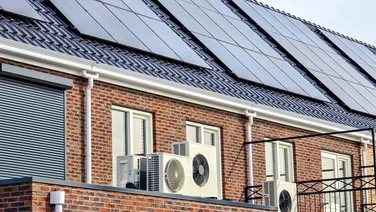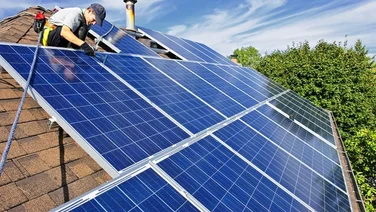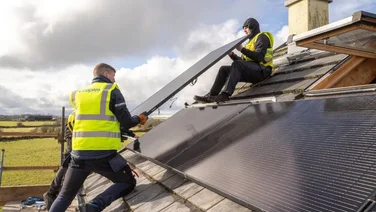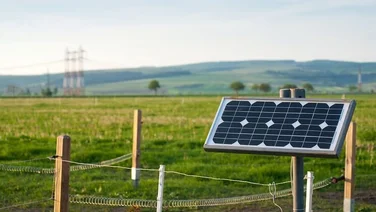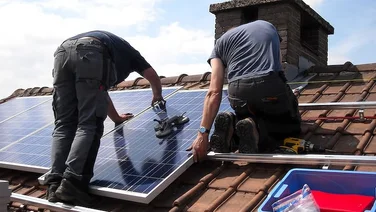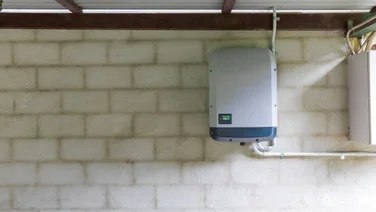- Solar trackers are special devices that keep solar panels facing the Sun as it moves through the sky
- While expensive, they can increase electrical production by as much as 35% once installed
- Solar trackers are heavy, bulky devices and are usually only appropriate for ground- or large flat-roofed PV installations
- They come in a range of types including manual, passive, and active tracking systems

Large single-axis solar tracking system in Phoenix, Arizona – credit: Mark Florence/FlickrSolar trackers are devices that let your solar panel array track the sun’s movement in the sky, helping you generate more solar energy.
Solar tracker costs are not cheap, but the additional power generated daily might just be worth the investment.
However, it should be noted that in the vast majority of smaller solar panel installations, it might make more sense just to install more solar panels.
Here, we’ll explore everything you need to know about solar trackers and determine whether they are worth the investment.
To find out how much solar panels will cost you, simply fill in this short form, and our suppliers will contact you with free quotes.
What is a solar tracker?
A solar tracker, as the name suggests, is a piece of technology that allows a solar panel to follow the movement of the Sun as it crosses the sky, generating as much energy as possible throughout the day.
Solar trackers are usually installed on ground-mounted solar panel installations, but they are increasingly finding a home on rooftop-mounted systems.
In either case, the solar tracking system is connected to a rack of moveable solar panels. This enables the entire array to be moved to get the best angle of attack from the Sun’s rays.
Trackers can usually adjust a solar panel’s angle and facing direction. The general idea of any system is to maintain the solar panels’ position as close to perpendicular to the Sun as possible.
By keeping the panel perpendicular to the Sun, more sunlight strikes the solar panel, less light is reflected, and more energy is absorbed, creating more electricity.
There are various designs for solar trackers, but they essentially provide the same function.
What types of solar tracker are available?

Example of a dual-axis solar tracking system – credit: Wikideas1/Wikimedia Commons
As previously mentioned, there are several different types of solar tracker. The primary examples include, but are not limited to:
- Manual solar trackers
- Passive solar trackers
- Active solar trackers
We’ll address each in more detail below.
1. Manual solar trackers
As the name suggests, manual solar panel trackers are trackers that require someone to physically adjust the panels at different times throughout the day in order to follow the Sun.
This is not always practical, as it necessitates someone constantly monitoring the sun and changing the position of the solar panel system.
2. Passive solar trackers
Passive trackers, on the other hand, contain a liquid with a low boiling point that evaporates when exposed to solar radiation. As the liquid evaporates, the tilt system becomes imbalanced, causing the panels to tilt toward the direction of the sun’s rays.
3. Active solar trackers
Active solar trackers are by far the most sophisticated of the three. These systems use motors or hydraulic cylinders to adjust the position of PV panels so that they are always facing the sun.
While this method is more convenient than manual tracking, the moving parts within the motors can break, which means higher maintenance costs over the system’s lifetime. Solar trackers can also be further categorised based on the direction in which they move.
These kinds of solar trackers come in two main types:
- Single-axis solar tracker
- Dual-axis solar tracker
Single-axis vs dual-axis solar trackers
Single-axis trackers follow the Sun’s position in one plane or axis as it moves from East to West. They are typically used in utility-scale solar projects and can boost production by between 25% to 35%.
They do this by effectively rotating a solar panel array at its base.
On the other hand, two-axis trackers can handle multiple directional changes (rotating on a base and tilting the panels) and are more commonly found in residential and small commercial solar projects with limited space. They allow these projects to generate sufficient power to meet their energy needs.
They are best suited for higher latitude locations, such as the UK, Canada, and New Zealand.
Dual-axis solar trackers are more complex things and come with higher price tags and maintenance costs. For this reason, a popular compromise is to use a single-axis solar tracker and then manually adjust the angle of your solar panels a couple of times each year.

Solar tracking systems are a great way to get the most out of solar panels – credit: Wikideas1/Wikimedia Commons
What are the benefits of solar trackers?
The benefits of solar trackers (irrespective of type) include:
- Increased energy production – Tracking systems, unlike fixed solar arrays, generate more energy by following the sun’s movements. Some, like single-axis trackers, can bump production between 25% and 35%.
- Improved PV efficiency – By continuously aligning the panels with the Sun, solar trackers ensure that the panels operate at their maximum efficiency, which can significantly enhance overall system performance.
- Better utilisation of space – Solar trackers can maximize energy production on available land, making them ideal for areas with limited space or utility-scale solar farms where maximizing output is crucial.
- Higher Return on Investment (ROI) – Although initial costs may be higher, solar trackers can generate increased energy output, resulting in quicker payback periods and higher overall ROI than fixed systems.
- Adaptability to various conditions – Modern solar trackers are engineered to endure diverse environmental conditions, such as wind and weather fluctuations, ensuring the solar power system’s dependable performance and long-term functionality.

Solar tracking systems are costly, but may be worth the investment- credit: Adsala/Wikimedia Commons
Are there any downsides to using solar trackers?
As great as solar trackers are, they are not without their limitations. These include, but are not limited to:
- They are expensive – Solar trackers can be quite costly and may significantly increase project expenses.
- Require ongoing maintenance – Solar trackers, which consist of moving parts, are more prone to breaking, leading to increased maintenance costs.
- Require more planning – Deciding to install trackers may require additional site planning and preparation, such as digging additional wiring trenches and extra site grading.
- They are bulky and heavy – Solar trackers are bulky and heavy, so they may not be appropriate for most roofs.

Close-up view of solar tracking system gear credit: Max D/Flickr
Is a solar tracker right for me?
Since they are so large and heavy, solar trackers are not commonly used in the residential solar industry. For this reason, they are usually not worth the extra investment, especially for residential solar systems.
If you have the space, increasing the number of installed panels is usually cheaper than investing in such a system. While they offer significant improvements in electrical generation yield, the costs will outweigh the benefits for any domestic-scale system. The opposite is true for larger commercial-scale (e.g., 100kWp) systems.
That being said, solar trackers can be useful when solar installation space is limited. If there isn’t enough space for extra solar panels, a solar tracking system can help produce more power in a limited area. Solar trackers are especially helpful for large-scale utility or commercial installations.
However, your location may also limit the utility or increase the cost of solar tracking systems in high-wind areas, for example. Solar tracking systems also generally work better in high-latitude locations that get more sunlight in the summer, so they could be beneficial if you live in Scotland or the North of England.
If you are considering them, it’s important to consult with a local solar installer to find out exactly how much a solar tracking system would cost you.

Image of a large-scale solar tracking system in Crescent Dunes, Nevada – credit: National Renewable Energy Lab/Flickr
How much do solar trackers cost?
Single-axis solar tracking costs around £0.85 (or $1.08) per watt.
Based on this estimate, here is the cost to mount a typical solar PV system on a single-axis tracker, ranging from a 1 kilowatt-peak (kWp) to a 4kWp system.
|
Solar PV system size |
Cost of single-axis tracker |
|---|


